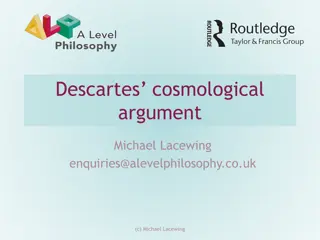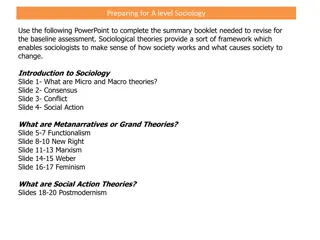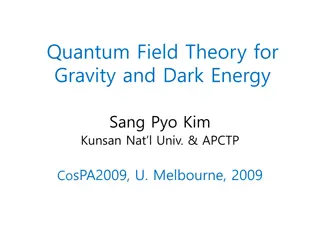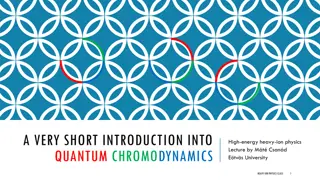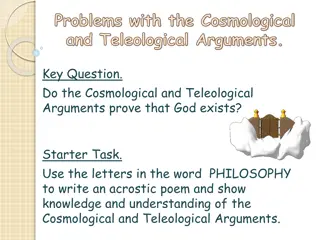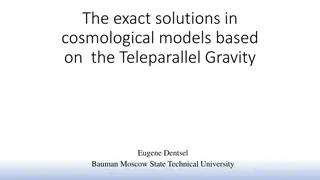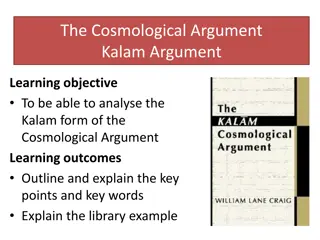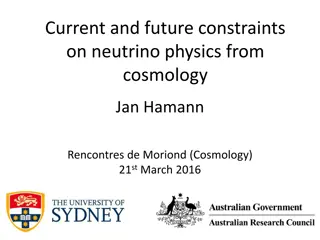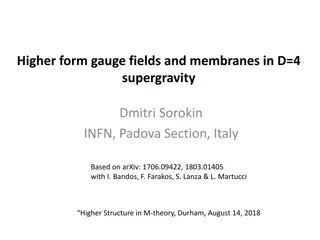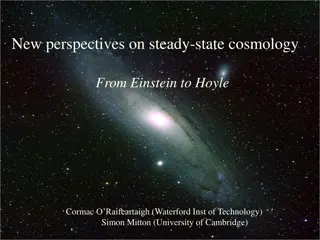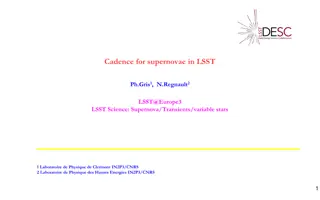Understanding Dark Energy Theories and Cosmological Dynamics
Exploring the concept of dark energy and its implications in the acceleration of the Universe. Various theories, including cosmological constants, vacuum energy, and modifications of General Relativity, are discussed. The role of vacuum fluctuations, gravitational coupling, and the challenges in describing late-time acceleration are highlighted.
Download Presentation

Please find below an Image/Link to download the presentation.
The content on the website is provided AS IS for your information and personal use only. It may not be sold, licensed, or shared on other websites without obtaining consent from the author. Download presentation by click this link. If you encounter any issues during the download, it is possible that the publisher has removed the file from their server.
E N D
Presentation Transcript
Dark Energy Theories Philippe Brax IPhT Dark Day SFP Champs et particules 25 November 2015
Comment le sait-on? Mesure de distances! Dark Energy: anything which leads to the late time acceleration of the expansion of the Universe ! As for inflation, many candidates, very few plausible
The acceleration of the Universe can be due to many causes: A cosmological constant and/or vacuum energy The cosmological dynamics of fields (new matter) A modification of General Relativity (GR) Crazoology
The acceleration of the Universe can be due to many causes: A cosmological constant and/or vacuum energy The cosmological dynamics of fields (new matter) A modification of General Relativity (GR) Crazoology
The acceleration of the Universe can be due to many causes: A cosmological constant and/or vacuum energy The cosmological dynamics of fields (new matter) A modification of General Relativity (GR) Crazoology
The acceleration of the Universe can be due to many causes: A cosmological constant and/or vacuum energy The cosmological dynamics of fields (new matter) A modification of General Relativity (GR) Causality Crazoology
The Cosmological Constant The cosmological constant comprises two terms: a bare cosmological constant which can be seen as a boundary condition set initially at the Big Bang and the sum of all the vacuum fluctuations. Vacuum fluctuations couple to matter (the Casimir effect) but do they couple to gravity? If yes they entail a serious problem: But what is the problem exactly? In a Lorentz invariant and causal effective field theory, the description of the late acceleration must be captured by a (very) low energy effective theory at energies well below all the mass scales of the standard model
The cosmological constant and masses correspond to renormalisable (relevant) operators at low energy. Their numerical values is sensitive to UV physics and must be determined at a given scale by comparison with experiments. This is the usual renormalisation programme where infinities are absorbed by infinite counterterms, leaving a finite value which is determined experimentally. The bare value of the cosmological plays the role of such a counterterm. In a top-down approach, every time a particle decouples, it contributes to the vacuum energy: Phase transitions (EW breaking, QCD) also contribute. The measurement of the dark energy now corresponds to the renormalisation condition at very low energy.
So what is the problem? From a bottom-up approach, there is no problem the dark energy is measured at low energy and one can integrate in all the particles of the standard model to take into account the effective vacuum energy in different eras of the Universe (before BBN, before the EW transition etc ) . In different eras, the effective cosmological constant is subdominant. From a top-down approach, there is a hierarchy problem. Why should my grand unified theory at very large energy know (or care) that when all the particles of the models have decoupled the sum of the bare cosmological constant, defined by the model at high energy, and the quantum fluctuations down to the electron (neutrino) scale should be ALMOST zero? This is a similar problem to the Higgs mass problem. In the early Universe, if inflation takes place and then ends, this sets the initial value of the cosmological constant to vanish and imposes that the contributions from the decoupling of the particles of the theory vanish. Why?
Weinbergs no-go theorem: A generic 4d Quantum Field Theory cannot admit a Poincar invariant vacuum with vanishing vacuum energy with non-vanishing fermion masses. Global SUSY is a counter example. One can violate some of the hypotheses to try to calculate the dark energy: Use extra dimensions (the curvature of the extra dimensions absorbs the vacuum energy) Use the dynamics of cosmological fields (quintessence)
A Simple Example: Pseudo-Goldstone Models Global U(1) symmetry broken at scale f: Symmetry broken by small term: Low energy potential: Cosmologically, if initially the field is small compared to f, it is frozen there until its mass becomes larger than the Hubble rate. Tuning this event to be in the recent past of the Universe and requiring that the dark energy is due to the low energy potential implies:
A major drawback of these models is that the phase transition must be at the Planck scale, this requires to embed this model in theories dealing with quantum gravity maybe embedding it in string theory although no global symmetries there On the other hand, this model is useful to see that low energy dark energy fields couple to matter: The derivative interaction implies no effect on static tests of gravity vs fifth forces. This an example of a disformal coupling to matter.
The Low Energy Dynamics Only interested in the dynamics of the Universe below the electron mass, i.e. after BBN. One scale has to be fixed to generate the dark energy. At low energy, write down the most general action of one scalar field with second order ODE s (Horndeski). with 4 arbitrary functions of the field and the kinetic term: The scalar field can couple to matter with the most general form respecting Lorentz invariance and causality: Bekenstein Conformal coupling Disformal coupling
On cosmological scales, the scalar field must be nearly massless in order to have an impact on the dynamics of the Universe. The two types of couplings have different consequences: Disformal coupling: increases the burning rate of stars Brax-Burrage Conformal coupling: induces a fifth force modification of Newton s law
Having both an effect on cosmological scales and preserving local physics requires a screening mechanism: Chameleon: screens in region of large enough Newtonian potential The mass of the scalar becomes density dependent: The field generated from deep inside is Yukawa suppressed. Only a thin shell radiates outside the body. Hence suppressed scalar contribution to the fifth force.
Having both an effect on cosmological scales and preserving local physics requires a screening mechanism: K-mouflage: screens in region where the gravitational acceleration is large enough This happens inside a large radius surrounding a compact object, the K-mouflage radius
Having both an effect on cosmological scales and preserving local physics requires a screening mechanism: Vainshtein: screens in region where the spatial curvature is large enough This happens inside a large radius surrounding a compact object, the Vainshtein radius
How is the motion of astrophysical objects affected? Trajectories due to gravity + scalar Chameleons: Unlike chameleons et al., K-mouflage and Vainshtein do not affect the charge Q: Outside the Vainshtein- Kmouflage radius, the object feels the scalar force outside the Vainshtein- Kmouflage radius
These three types of theories affect the growth of large scale structure in different ways: Chameleons: Mpc 10 Mpc Non-linear screening for large Newton potential . linear screening outside the Compton wavelength of chameleon. K-mouflage: Mpc 10 Mpc Non-linear screening inside K- mouflage radius . No screening on cluster scales For Vainshtein, even clusters are screened.
More precisely on linear scales, the growth is affected: Chameleon: Scale-time dependence K-mouflage: Time dependence only
Power spectrum Brax-Valageas Number of clusters Linear growth:
Galileons Theories with the Vainshtein screening. Non-renormalisation theorem and negligible finite corrections on large scales. Self-accelerated solutions The cubic Galileon: Unfortunately, ghosts in Minkowski space: cannot be embedded in healthy UV completion.
K-mouflage K-mouflage screening. Non-renormalisation theorem and negligible finite corrections on large scales. The quadratic K-mouflage: 2-body scattering violates perturbative unitarity : Such theories can be embedded in a UV completion with QFT axioms if: No standard UV-completion
Massive Gravity Mass term for a graviton The simplest modification is massive gravity (Pauli-Fierz): Pauli-Fierz gravity is ghost free (negative kinetic energy terms) . Unfortunately, a massive graviton carries 5 polarisations when a massless one has only two polarisations. In the presence of matter, the graviton wave function takes the form: The massless limit does not gives GR! (van Dam-Velman-Zakharov discontinuity). The extra polarization is lethal. Solved by Vainshtein mechanism (non-linearity). Ghost in curved space-time!
Bimetric Gravity One way to cure these problems is to consider a non-linear version of massive gravity with two dynamical metric: where the graviton mass is of order Only a linear combination of the vielbeins couple to matter: Only the beginning a lot more work to understand theoretically and then compare to data!
Crazoology (part one) Models like K-mouflage seem to be low energy theories with no UV completion? Are they ruled out? At high energy, unitarity is restored because the theory becomes non-local with the creation of finite size objects. It is said to classicalise (Dvali et al.) This is the analogous to the creation of black holes at high energy when the size of the interaction region is smaller than the Schwarszchild radius. Here the same would happen when this size is smaller than the K-mouflage or Vainshtein radius.
Crazoology (part two) The cosmological constant problem indicates a failure of the effective field theory description at low energy. Indeed, in a top-down approach, the value of the cosmological constant now in the IR depends both on the whole history of the Universe (the masses of all the particles which decouple one by one and all the phase transitions) and the UV value of the cosmological constant (the bare one). This suggests that a theory which would explain its value would have a strong correlation between UV and IR physics. Recalling that UV=early Universe and IR=late Universe, this suggests a global breaking of causality. Kaloper-Padilla The function of the two fields (x) and (x) is a global function. The dynamics of this theory are very close to GR:
The crucial difference is that the effective cosmological constant is determined globally: This models requires that the Universe is spatially finite and that the future is not infinite. In fact the Universe must end in a big crunch singularity. The effective value of the cosmological constant violates causality globally as it depends on the whole space- time, even our finite future. The vacuum contribution, from loops etc , does not gravitate! where the effective cosmological constant depends on the average of the matter energy densities and is set by a future boundary condition:
Conclusions The discovery of dark energy is a fantastic opportunity to reappraise all the tenets of our standard description of the Universe. It raises deep questions about Quantum Field Theory: UV sensitivity, UV completion, causality It raises deep questions about gravity: modified gravity, massive gravity It is linked to exciting new experiments from laboratory tests to cosmology




